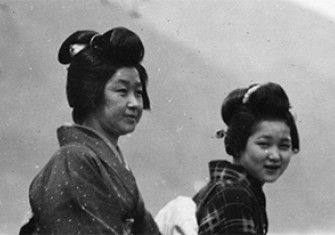The Birth of Emperor Hirohito
Japan's 124th Emperor was born on April 29th, 1901

Born a sickly baby in Tokyo, Hirohito would grow up to enjoy or endure a reign of 62 years, the longest in Japanese history. His mother was the Princess Sadako, who had been married at 16 almost a year before to the Crown Prince Yoshihito and would soon bear him two more sons. Much the most impressive member of the family was the boy's grandfather, the formidable Meiji Emperor, who ruled until 1912 and presided over the westernisation which brought Japan out of isolation into the modern world. Even so, the Emperor was still considered a divine being, the Son of Heaven. On the rare occasions when he appeared in public, the crowds in the streets bowed their heads and the shutters of all windows above ground level were closed so that no one could commit the sacrilege of looking down on him from above.
By custom, the newborn baby was ceremonially washed while a classic text was read aloud to him and an archer in antique garb plucked the string of a bow to drive evil spirits away. After seventy days he was taken away from his mother and entrusted to a guardian, Count Sumiyoshi Kawamura, a former naval officer who made sure that the boy was taught that he would inherit the imperial throne and must behave accordingly. Before he was four, Hirohito was returned to his father’s Akasaka Palace in Tokyo, where he lived with his younger brothers. They were allowed to see their mother once a week, but seldom saw their father, who had retreated into the arms of his concubines and was showing signs of mental illness. Five little boys from high-ranking families were recruited as playfellows for the imperial children. Their education was in the hands of a strict disciplinarian named Kinsaku Maruo, who again made sure that Hirohito understood his position in the world. There’s a story that when the boys were lining up to jump off a low wall, Maruo intervened to stop Hirohito jumping, on the grounds that it was an unseemly course of action for a future ruler of Japan. The other boys preferred to play with Hirohito's brother, Chichibu, who was lively and outgoing, while Hirohito was clumsy, short-sighted and shy.
In 1908 the young prince was sent to a special class of twelve boys at the Peers' School, reserved for the children of aristocratic families. The subjects taught included English, geography, drawing, calligraphy, singing and gymnastics. The headmaster was a battle-scarred veteran, General Maresuki Nogi, whose own two sons had been killed under his command in the siege of Port Arthur during the Russo-Japanese War. He was an incarnation of bushido, the warrior code of the samurai, which he inculcated in his pupils, and a warm relationship developed between him and the prince.
The relationship was broken when Hirohito was eleven, when the Meiji Emperor died. General Nogi sent for the boy, expressed his approval of Hirohito's progress and told him that he must always work hard for the sake of Japan. They bowed to each other and Hirohito left the room. Nogi and his wife put on ceremonial dress and in front of a portrait of the Emperor he stabbed her in the heart, then plunged the sword into his own entrails and partially cut off his own head in a ritual suicide to follow his dead lord. Hirohito had learned not to betray his emotions and received the news with correct impassivity.
Hirohito’s father, Yoshihito, succeeded to the throne as the Taisho Emperor, but in 1921 Hirohito was named prince regent when the new ruler's mental troubles made his retirement imperative. He finally succeeded as Emperor himself in 1926. Ironically, the name chosen for his reign was Showa, meaning 'enlightened peace'.






